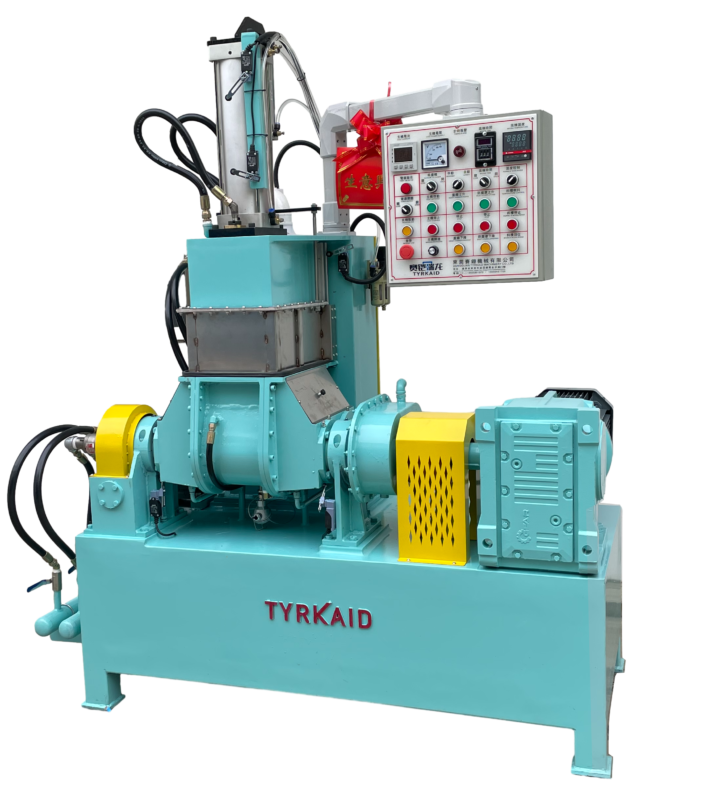Introduction

Internal mixers are critical in the rubber and plastics industries, primarily used for mixing raw materials to produce a homogeneous compound. These machines ensure that various components, such as polymers, fillers, and additives, are uniformly distributed to achieve the desired material properties. This chapter delves into the design, operation, and significance of internal mixers, focusing on their role in rubber processing.
1. Historical Development
The concept of internal mixing dates back to the early 20th century when the demand for more efficient rubber mixing processes led to the invention of the Banbury mixer by Fernley H. Banbury in 1916. This invention revolutionized the rubber industry, providing a more consistent and efficient method of mixing compared to the traditional open mill process.
2. Design and Components
Internal mixers are robust machines designed to handle high shear forces and temperatures. The primary components include:
- Mixing Chamber: A robust, enclosed chamber where the mixing takes place. It is designed to withstand high pressures and temperatures.
- Rotors: Typically two counter-rotating rotors, which can have various designs (e.g., tangential, intermeshing) to suit different mixing requirements.
- Ram: A hydraulic or pneumatic ram that applies pressure to the material, forcing it into the mixing chamber and ensuring efficient mixing.
- Drive System: Usually an electric motor that drives the rotors, providing the necessary torque and speed for mixing.
- Cooling and Heating Systems: To control the temperature within the mixing chamber, ensuring optimal processing conditions.
3. Mixing Process
The mixing process in an internal mixer involves several stages:
- Loading: Raw materials, including polymers, fillers, and additives, are loaded into the mixing chamber.
- Initial Mixing: The rotors begin to rotate, and the ram applies pressure, causing the materials to undergo shear and elongational forces, leading to initial dispersion.
- Dispersive Mixing: High shear forces further break down agglomerates of fillers and ensure uniform distribution.
- Distributive Mixing: Continued mixing ensures that all components are evenly distributed throughout the compound.
- Discharge: Once the compound reaches the desired consistency and temperature, it is discharged from the mixer for further processing.
4. Types of Internal Mixers
Internal mixers come in various designs, tailored to specific applications:
- Banbury Mixers: The most common type, featuring tangential rotors that provide high shear forces.
- Intermeshing Mixers: Rotors intermesh with each other, providing a different mixing action compared to tangential mixers, often used for more delicate compounds.
- Kneaders: Typically used for lower shear applications, featuring a single rotor design.
5. Applications in Rubber Processing
Internal mixers are indispensable in rubber processing, used for:
- Compounding: Creating rubber compounds with specific properties by mixing polymers, fillers, and additives.
- Masterbatch Production: Producing masterbatches, which are concentrated mixtures of pigments and additives dispersed in a carrier material.
- Recycling: Reprocessing scrap rubber into usable materials.
6. Advantages of Internal Mixers
Internal mixers offer several advantages over other mixing methods:
- Efficiency: High shear forces and controlled conditions lead to faster and more efficient mixing.
- Consistency: Produces uniform compounds with consistent properties.
- Versatility: Capable of handling a wide range of materials and formulations.
- Scalability: Suitable for both small-scale and large-scale production.
7. Challenges and Considerations
Despite their advantages, internal mixers also present certain challenges:
- Energy Consumption: High power requirements due to the intense mixing action.
- Maintenance: Wear and tear on rotors and other components require regular maintenance.
- Heat Management: Effective cooling systems are essential to prevent overheating and degradation of materials.
8. Future Trends
The future of internal mixers in rubber processing is likely to be influenced by several trends:
- Automation: Increasing use of automation and control systems to improve efficiency and consistency.
- Sustainable Practices: Development of energy-efficient designs and processes to reduce environmental impact.
- Advanced Materials: Adaptation to new materials and formulations, including nanocomposites and bio-based polymers.
Conclusion
Internal mixers are a cornerstone of the rubber processing industry, providing the necessary technology to produce high-quality rubber compounds efficiently. Understanding their design, operation, and applications is crucial for anyone involved in rubber manufacturing. As the industry evolves, internal mixers will continue to play a vital role, adapting to new challenges and opportunities.

